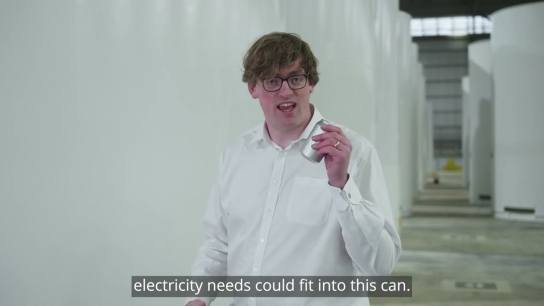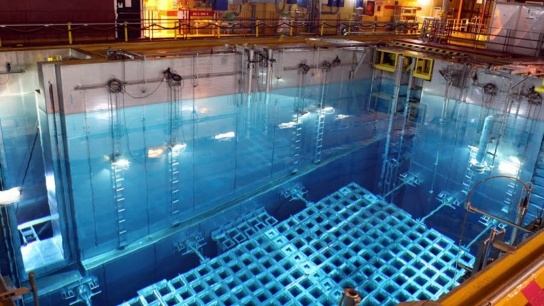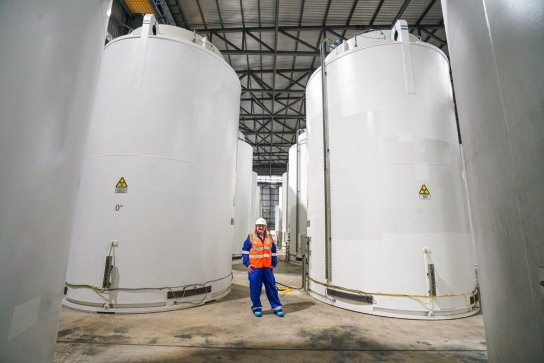Managing Spent Fuel at Hinkley Point C
Radioactive waste and spent fuel is produced as a result of electricity generation in nuclear power stations and from the use of radioactive material in industry, defence, medicine and scientific research.
Unlike other harmful industrial waste products like carbon dioxide, radioactive waste is produced in small amounts and has already been safely stored and secured for very long periods of time. Since the oldest stations in our fleet started generating in 1976, they have helped avoid the emission of 700 million tonnes of CO2 – making a huge difference in the fight against climate change.
In the UK, spent nuclear fuel which is removed from the reactor itself, is safely stored at power stations in specialist facilities before being moved to a future geological disposal facility currently being developed by the UK's Nuclear Waste Services (part of the Nuclear Decommissioning Authority).

Spent fuel is produced in such small amounts that the total volume from an average person's lifetime electricity needs could fit into a drinks can.
Changing the way we store spent fuel
We are considering changing the way in which we will store spent fuel. The change is from the originally proposed “wet” design, where spent fuel is stored in large pools, to one which uses “dry” storage - where spent fuel is stored in very strong cannisters inside a building.
In the 12 years since our original review of storage options, a new dry store at Sizewell B in Suffolk has given us UK operational experience of using this method. It provides benefits in terms of easier handling and accessibility and the advantage of passive cooling and shielding, requiring no operator intervention.
The dry store technology has been used worldwide since the 1970s. Tests on spent fuel cannisters after decades in dry storage has confirmed that the system continues to provide a very safe and secure storage option. The concrete and steel cannisters are very robust and are designed to withstand any external hazard. They can be approached without any protective clothing – as they completely shield the environment from the radiation of the spent fuel.
Use of the technology is overseen by our independent regulators the Environment Agency and the Office for Nuclear Regulation.
Different types of storage
In the very early stages of Hinkley Point C’s design we considered a range of different ways to store the power station’s spent fuel. Both “wet” and “dry” storage were considered to be the best available techniques and both suitable for use at Hinkley Point C. The original decision to propose a “wet” store over a “dry” store was very close and based upon the operational experience at the time, together with the ease of inspection.


Dry storage
In a dry-store, spent fuel is stored in very strong steel cannisters inside a building.
Compared to wet-storage, a dry-store provides benefits in terms of reduced maintenance, greater passive safety that does not require any operational intervention and a more levelised cost. Dry storage is not actually any cheaper overall, but the cost is spread across the operation of the power station more evenly.
What difference will this change make?
One of the main differences between the two storage methods is that less fuel is put into each dry-store cannister than would be seen in a wet-store. This means that a larger building will be required for a dry-store. It will be a longer building to provide the necessary space needed for the casks whilst also being slightly taller. This is because a wet-store can be slightly sub-merged, something that is not possible in a dry-store where better access is required, and good airflow maintained.
The proposed change also removes much of the maintenance necessary with wet-storage ponds as the cannisters used in a dry-store do not require any form of active management. This also means that the future decommissioning of Hinkley Point C can be carried out more safely and in a faster timeframe.
The cannisters do not require any direct cooling which is maintained passively by natural air-flow around the sealed containers and does not require any operational intervention.
There will be capacity to safely store all of Hinkley Point C’s spent fuel generated through the entirety of the plants operation and its designed to store the spent fuel generated by Hinkley Point C only - there are no plans to see waste materials moved to the area from any other power station.
Is this a new way of storing waste?
The dry store technology has been used worldwide since the 1970s. Tests on spent fuel cannisters after decades in dry storage has confirmed that the system continues to provide a very safe and secure storage option. The concrete and steel cannisters are very robust and are designed to withstand any external hazard. They can be approached without any protective clothing – as they completely shield the environment from the radiation of the spent fuel.
An independent view on waste
Mark Lynas is an environmentalist and author of several books on the pressing need to tackle climate change. He recently visited Sizewell B’s spent fuel store, publishing an article which summarised his experience.
Dry fuel storage has been used for many years at sites across the world, including the USA, Canada and Germany. In the United States more than 2,400 casks have been loaded and are safely storing 100,000 spent fuel assemblies. Tests on spent fuel and cask components after years in dry storage confirm that the systems continue to provide a safe and secure environment for the waste products.

Contact us
The best way to contact us about Hinkley Point C is by completing our online enquiry form. You can also call us on 0333 009 7070 (24 hour free phone number).
For EDF's 24/7 media enquiry line call 01452 652233.